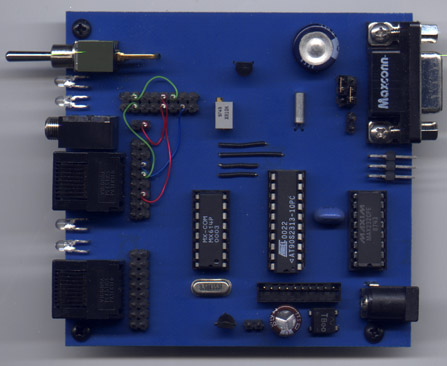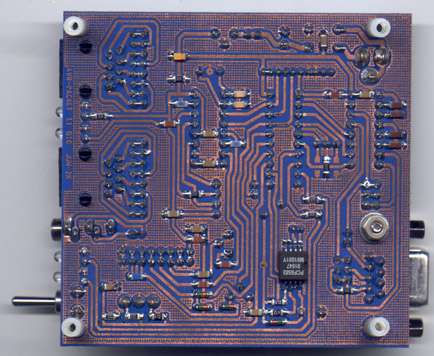Here is some experimental hardware and software to transmit
and receive AX.25 packets.
It is essentially a PIC-E clone designed around a Atmel AT90S2313
with a few extra bells and whistles.
I had picked up a couple of MXCOM MX-614s at the TAPR display (I
also joined TAPR) at the Dayton Hamvention, and I needed a
project to try them out on. I had designed many projects around
Microchips PIC series micros, but had recently started
experimenting with Atmel AVR micros. On the pic mail list this is
referred to as 'going over to the dark side'. AVRs are PIC
like risc processors, but with some additional features that made
them slightly more suited for certain projects. AVRs are also
very cost competitive against midrange PIC parts. Simple flash
based in circuit programming and cheap development tools also
contribute the the attractiveness of the AVR processors. AVRs
also code very well in C, but I'm still stuck with slugging away
with assembler.
Most of the AVR devices are available now from Digi-Key or other online sources. Digi-Key also stocks the STK-500 starter kit which is a great way to start working with Atmels for a very reasonable price.
NOTE: This project is not intended as a PIC-E or MIC-E (I guess I could call it the AVR-E) replacement or competitor. It's just as another tool to further increase the utility of APRS. The hardware is pretty flexible, the example code implements a very basic UI-TNC, but you could easily edit out the console code, leave the AX.25 encode/decode routines to create trackers, WX stations or minimal function digipeaters. It should also be possible to implement an almost complete KISS modem, the main limiting factor is ram.
Parts availability: If anyone has trouble finding some of the parts for the project, I have some spare PCF8583s (I only have smd parts for the PCF8583, sorry) . You can find them on my FOR SALE page. I'm not trying to make any profit on any parts for this project, just trying to cover my expenses.. I'm sorry that I have no source to recommend for small quantities of the FM25160.
NEW: Here is a revised design. Hardware REV 1.5, software 1.7.
The newer deisign no longer uses the PCF8583 I2C RAM/RTC. After the generous donation of some sample RAMTRON FM25160 fram parts by Klaus Hirschelmann I revised the hardware. We now have 2K of storage but no RTC. I simplified the Beacon function and used some of the additional storage to buffer incoming packets. I also made some minor changes to the hardware based on input from Klaus. The schematic and source code may be downloaded as one archive.
![]() AVR_UI_TNC FRAM .
Source code for version 1.7 of AVR_UI_TNC.ASM and pdf schematic
for hardware Rev. 1.5.
AVR_UI_TNC FRAM .
Source code for version 1.7 of AVR_UI_TNC.ASM and pdf schematic
for hardware Rev. 1.5.
![]() Source code.
Source code for version 1.0 of AVR_UI_TNC.ASM (uses PCF8583 RTC).
Source code.
Source code for version 1.0 of AVR_UI_TNC.ASM (uses PCF8583 RTC).
![]() Schematic of test board.
.pdf file of revision 1.0 schematic.
Schematic of test board.
.pdf file of revision 1.0 schematic.
Construction Notes:
There is no printed circuit board or enclosure available at
the moment. This is really just an experimental test bed, It was
designed for flexibility. The RJ-45, stereo audio connector, and the
configuration headers should make it possible to configure the board for almost
any radio.
I made my own pc board using toner transfer paper and here are my
results. For the record I like designing with smd parts on my
prototypes because I can make fairly compact single sided boards,
and I don't have to drill so many holes. On my projects page is a acrobat
document that describes my experiences with home PCB manufacturing. Some people
may find it useful.
![]() http://users.rcn.com/carlott/toner_transfer_exp.pdf
http://users.rcn.com/carlott/toner_transfer_exp.pdf
If anyone actually wants the artwork for the 1.5 hardware, email me, and I'll send it out.
And if you have any questions or comments please email me: carlott@rcn.com Henry Carl Ott N2RVQ
Top of the Rev. 1.0 prototype You can see the use of wire wrap jumpers to
configure the Microphone connector.

Bottom of the Rev. 1.0 prototype

Page revised Mar-2002